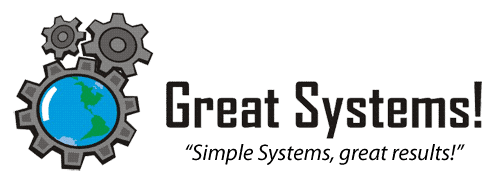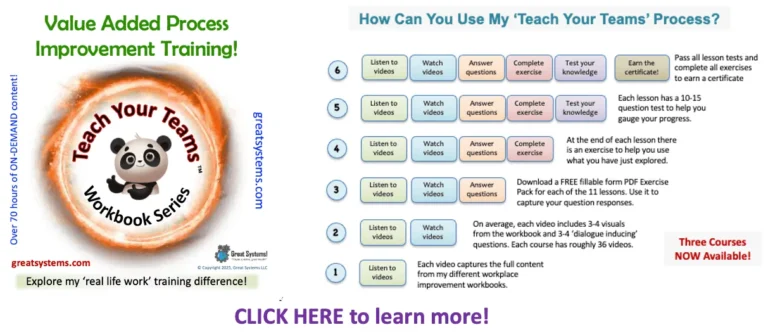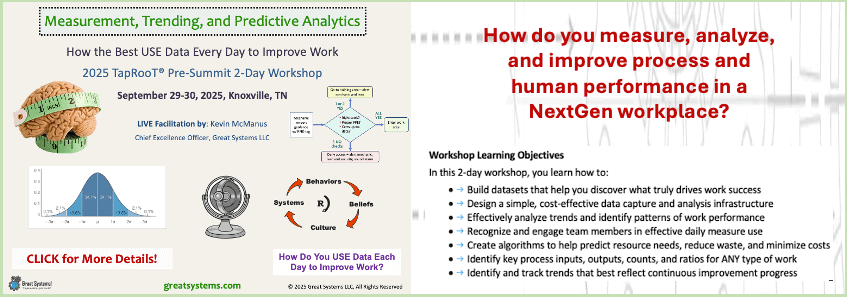Four Steps to Effective Rule Enforcement
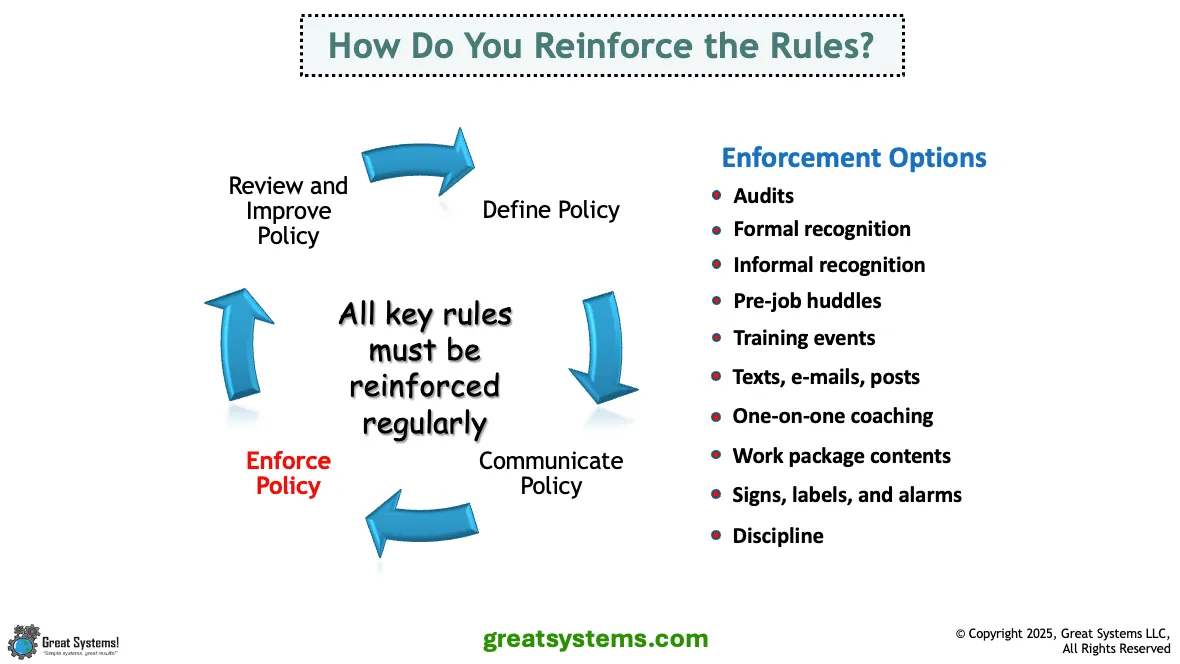
Four Steps to Effective Rule Enforcement
Do you want to help your work team leaders maximize rule compliance and raise work team commitment levels? If so, use the four steps of effective rule enforcement. The four-step enforcement process I use to achieve near 100% compliance is not that complicated.
However, it is different than the rule enforcement approaches most organizations use. As rule following is a key aspect of high performance work, I thought I would take the time to share this process with you.
However, it is different than the rule enforcement approaches most organizations use. As rule following is a key aspect of high performance work, I thought I would take the time to share this process with you.
Why Do People Break Rules?
Multiple reasons help explain why people break rules. However, we all too often fail to effectively address such rationale to improve rule compliance, let alone commitment.
Instead, we rely on punishment, reminders, and reprimands. Such weak fixes are not sustainable. How effective are your rule enforcement steps?
Whenever I teach a TapRooT® root cause analysis course, I get the chance to see an effective four-step rule enforcement process in action. To enhance learning, we take breaks every hour. With each break comes the opportunity for people to break the rules.
What percent of the class comes back from the ten-minute break on time? It all depends on how the facilitator enforces class break rules.
Instead, we rely on punishment, reminders, and reprimands. Such weak fixes are not sustainable. How effective are your rule enforcement steps?
Whenever I teach a TapRooT® root cause analysis course, I get the chance to see an effective four-step rule enforcement process in action. To enhance learning, we take breaks every hour. With each break comes the opportunity for people to break the rules.
What percent of the class comes back from the ten-minute break on time? It all depends on how the facilitator enforces class break rules.
If I could suggest one change to significantly increase the likelihood that your performance improvement initiative would succeed, what would it be? After much research and reflection, I can finally provide that answer after giving the question much thought as it related to my own past successes, failures, and learnings.
WATCH over 50 kaizen and workplace health improvement videos on my Great Systems YouTube channel.
WATCH over 50 kaizen and workplace health improvement videos on my Great Systems YouTube channel.
Step 1: Clearly Define and Communicate the Rules for Effective Rule Enforcement
Clarity and repetition are two keys to effective rule communication. All too often, we write the rules in a very general nature.
Plus, we state the rules only one time. We rely on others to communicate our policies for us. However, we often fail to attach the right emotional emphasis – positive or negative – to such communications.
Often, leaders write rules in a ‘one size fits all’ style. This allows flexibility in application. Unfortunately, they may not realize that such generality also invites higher levels of non-compliance.
In the classroom example, very different behaviors occur when we emphasize the need to be ‘back in the room and in your seat’ rule. If we simply ask people to ‘be back in the room’ before the break time expires, we get lower on-time compliance.
Plus, we often fail to appreciate the fact that people have different communication preferences. Some people understand and retain written communiques much better than others.
Verbal, face-to-face communications often work the best. However, we often don’t want to take the extra time to share information multiple ways.
Plus, we state the rules only one time. We rely on others to communicate our policies for us. However, we often fail to attach the right emotional emphasis – positive or negative – to such communications.
Often, leaders write rules in a ‘one size fits all’ style. This allows flexibility in application. Unfortunately, they may not realize that such generality also invites higher levels of non-compliance.
In the classroom example, very different behaviors occur when we emphasize the need to be ‘back in the room and in your seat’ rule. If we simply ask people to ‘be back in the room’ before the break time expires, we get lower on-time compliance.
Plus, we often fail to appreciate the fact that people have different communication preferences. Some people understand and retain written communiques much better than others.
Verbal, face-to-face communications often work the best. However, we often don’t want to take the extra time to share information multiple ways.
Step 2: Provide Consistent Rule Compliance Feedback
In class, we project a big clock on the screen at the front of the room. Such feedback clearly lets people know how much break time is left. We don’t expect them to track their own time as the only feedback source.
Similarly, speed limit signs that are paired with a current speed indicator do a better job of keeping excessive speeds down. Layers of enforcement, provided in a positive way and in a timely manner, make a big difference.
How do you provide your people with ‘real time’ rule compliance performance? How often do they only follow the rules when they know someone is watching? I learned years ago that the adage ‘No feedback, no motivation’ really matters.
Such feedback does not have to be negative or punitive. However, leaders need to consistently provide it. That is why consequences, both positive and negative, are important.
Similarly, speed limit signs that are paired with a current speed indicator do a better job of keeping excessive speeds down. Layers of enforcement, provided in a positive way and in a timely manner, make a big difference.
How do you provide your people with ‘real time’ rule compliance performance? How often do they only follow the rules when they know someone is watching? I learned years ago that the adage ‘No feedback, no motivation’ really matters.
Such feedback does not have to be negative or punitive. However, leaders need to consistently provide it. That is why consequences, both positive and negative, are important.
Step 3: Define and Enforce Positive Over Negative Consequences
People often view enforcement as only as a negative thing. If people know they will get in trouble if they break the rules and get caught, what becomes the goal? Do we follow the rules or not get caught?
With the proper emphasis and reasoning, we can easily shift one’s focus towards the positive consequences of rule compliance. When we recognize people who do the right things, we help foster personal pride and commitment over time.
Leaders need to stress the positive, as well as negative, outcomes for following the rules. Positive consequences don’t have to always be extrinsic in nature.
Team members all gain enhanced job security and a safer working environment when they follow fair rules. Plus, it is not uncommon to gain happier customers and waste less time. I find that the best enforcement strategy is to provide positive, meaningful, daily, and consistent feedback.
In our TapRooT® root cause analysis class example, the consequences are simple. We give out a playing card for being back in the seat on time. There is a chance to play best and worst hand poker for a prize. If someone returns from break late, they don’t get a card.
People rarely return late from break however, even though the prizes are relatively low in cost. People want recognition when they do the right thing. Don't you?
With the proper emphasis and reasoning, we can easily shift one’s focus towards the positive consequences of rule compliance. When we recognize people who do the right things, we help foster personal pride and commitment over time.
Leaders need to stress the positive, as well as negative, outcomes for following the rules. Positive consequences don’t have to always be extrinsic in nature.
Team members all gain enhanced job security and a safer working environment when they follow fair rules. Plus, it is not uncommon to gain happier customers and waste less time. I find that the best enforcement strategy is to provide positive, meaningful, daily, and consistent feedback.
In our TapRooT® root cause analysis class example, the consequences are simple. We give out a playing card for being back in the seat on time. There is a chance to play best and worst hand poker for a prize. If someone returns from break late, they don’t get a card.
People rarely return late from break however, even though the prizes are relatively low in cost. People want recognition when they do the right thing. Don't you?
Step 4: Measure and Improve the Rule Enforcement Process
Rule enforcement is a key management activity that we often fail to measure. Even in those cases where we do audit compliance to the rules, we often fail to trend such performance over time. Worse yet, we fail to improve our enforcement practices. Instead, we continue to punish more people when rules are broken.
In our ‘back from break’ example, it is easy to see when we achieve 100% compliance. In the workplace however, compliance is much harder to see.
This is especially true if leaders limit process audits to an external group that only performs spot checks. Process owners need to monitor and work with their own people in a cooperative manner. Each day, work team leaders must emphasize the importance of rule compliance in a meaningful way.
Most importantly, we have to change our work systems to remove barriers to good workmanship. W. Edwards Deming convinced me that most people want to do a good job.
When we make it hard for people to follow the rules, rule compliance and commitment percentages drop dramatically. The same result occurs when we fail to define the true positive outcomes that come with consistently following the rules.
In our ‘back from break’ example, it is easy to see when we achieve 100% compliance. In the workplace however, compliance is much harder to see.
This is especially true if leaders limit process audits to an external group that only performs spot checks. Process owners need to monitor and work with their own people in a cooperative manner. Each day, work team leaders must emphasize the importance of rule compliance in a meaningful way.
Most importantly, we have to change our work systems to remove barriers to good workmanship. W. Edwards Deming convinced me that most people want to do a good job.
When we make it hard for people to follow the rules, rule compliance and commitment percentages drop dramatically. The same result occurs when we fail to define the true positive outcomes that come with consistently following the rules.
More Content with a Total Work Team Engagement Focus:
Connect with Me for Positive Rule Enforcement Ideas!
How effective are your rule enforcement steps? Would a systems change or two give you better results? Keep in mind that I devote significant time to the rule enforcement topic in my 'Corrective Action Tactics and Mistake Proofing' workshop overview PDF. Please check it out!
